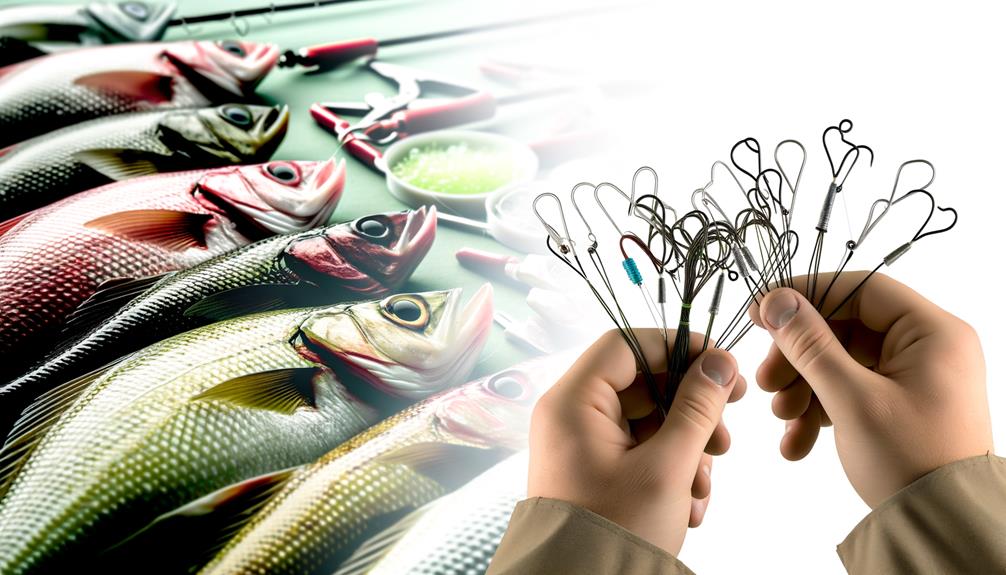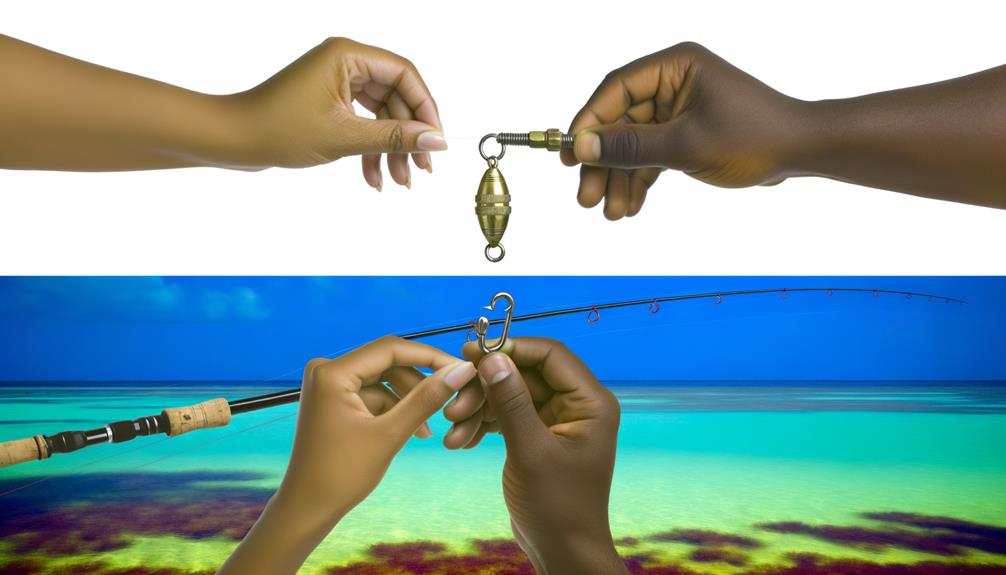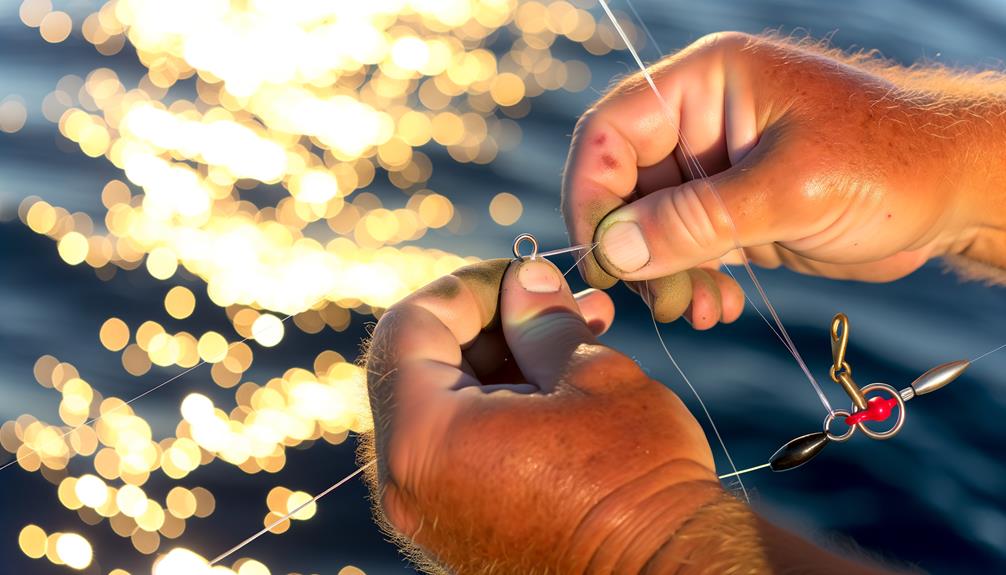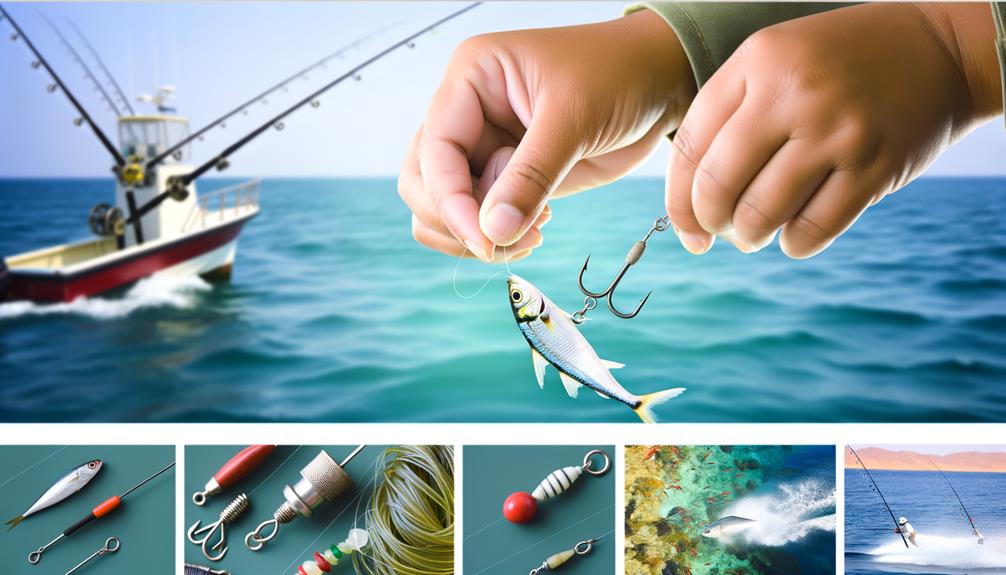The Carolina Rig, a staple in the saltwater angler's toolkit, is renowned for its adaptability and effectiveness in attracting a variety of fish species. Constructing such a rig involves careful selection of components to ensure optimal performance.
While the process might seem daunting to beginners, with the right guidance and precision, it is rather straightforward. Let's initiate a discussion on how to assemble a Carolina Rig for saltwater fishing, where we will explore the necessary materials, assembly techniques, bait selection, and usage tips.
There's much to learn for both novice and seasoned anglers alike.
Key Takeaways
- The Carolina Rig is versatile and effective for saltwater fishing, particularly in windy or murky waters.
- Assembling the rig involves using a 20lb monofilament leader line, size 5 barrel swivel, 1/0 kahle hook, 3/8 oz lead egg sinker, and 8mm glass bead.
- Selecting the right leader and hook, and securing them properly is crucial for optimal rig performance.
- Bait selection, whether live or artificial, should be based on the dietary habits of target fish for successful catches.
Understanding the Carolina Rig
The Carolina Rig, a versatile setup commonly utilized in saltwater fishing, is a highly effective tool for targeting species such as speckled trout and redfish due to its unique construction and natural bait presentation. Comprising a sliding egg sinker, bead, swivel, leader line, and hook, the rig allows bait to move freely underwater, mimicking the behavior of live prey to attract fish.
The Carolina Rig is notably ideal for fishing in windy and murky waters, demonstrating its effectiveness in depths of 3 feet or more. This makes it an indispensable asset to any angler's toolkit, with the potential to yield significant catches when used correctly. Furthermore, the use of a circle hook with the Carolina Rig plays a significant role in its effectiveness. The circle hook not only facilitates easier hooking but also prevents the deep hooking of the fish, thereby enhancing the angler's chances of a successful catch.
Additionally, adjusting the weight of the leader based on water conditions and fish size can substantially improve the effectiveness of the Carolina Rig setup. This highlights the rig's adaptability, making it a practical choice for various fishing scenarios.
Necessary Materials for Rigging
To construct an effective Carolina Rig for saltwater fishing, certain materials are not only beneficial, but essential. Your rig's efficacy and durability will rely heavily on the quality of these components.
In the following discussion, we will be examining the importance of gathering the right supplies and choosing materials of superior quality for your rig.
Gathering Essential Supplies
In preparing a Carolina rig for successful saltwater fishing, one must first assemble a collection of essential materials. These include a 20lb test monofilament leader line, a size 5 barrel swivel, a 1/0 kahle hook, a 3/8 oz lead egg sinker, and an 8mm glass bead.
The egg weight or sinker, which is to be slid onto your main line, plays an integral role in providing the proper depth and movement for your bait. The main line, connected to the barrel swivel, ensures that your rig remains securely fastened.
Each component is uniquely significant to the overall functionality of your Carolina rig. Gathering these supplies is the first step towards creating an optimal setup for saltwater fishing, thereby enriching your angling experience.
Selecting Quality Materials
After successfully gathering your essential supplies, it becomes paramount to understand the importance of selecting quality materials for rigging your Carolina rig, as each component plays a crucial role in its overall performance during saltwater fishing.
For Carolina rigging, a 20lb test monofilament leader line is deemed ideal. Size 5 barrel swivel serves as an indispensable connector for the leader line and main line. A 1/0 kahle hook is highly recommended for effective fish hooking. A 3/8 oz lead egg sinker aids in proper sinking and stability in water. To make your rig more attractive to fish, consider adding an 8mm glass bead for underwater sound effects.
| Material | Use |
|---|---|
| 20lb Monofilament line | Leader Line |
| Size 5 Barrel Swivel | Connects Leader and Main Line |
| 1/0 Kahle Hook | For Hooking Fish |
| 3/8 oz Lead Egg Sinker | For Sinking and Stability |
| 8mm Glass Bead | For Attraction and Sound Effects |
Choosing the Right Leader

Selecting an appropriate leader for your Carolina Rig is a critical step; a 20lb test monofilament leader line often serves as an excellent choice for saltwater fishing. This line strength not only provides the needed durability and resilience for Carolina rigs but also ensures a reliable connection between your rig and your targeted catch.
However, the leader's weight may require adjustment based on the water conditions and target fish species. For instance, a heavier leader line like a 40lb test mono might be necessary when targeting larger species such as redfish or fishing in murky waters. This is because a heavier line provides increased strength and abrasion resistance, vital factors when wrestling with bigger fish or navigating through debris-filled waters.
It's important to note that fluorocarbon leader lines are not typically recommended for Carolina rig setups. This is due to their stiffness and reduced knot strength compared to monofilament lines. Also, a sturdier leader can prevent fish from swallowing the hook, which significantly aids in catch and release efforts. Therefore, choosing the correct leader for your Carolina Rig is not only a matter of efficiency but also promotes ethical fishing practices.
Assembling the Main Line
While assembling the main line of your Carolina rig for saltwater fishing, a 20lb test braided line is often an excellent choice. The strength and sensitivity provided by this line are unparalleled, making it incredibly suitable for handling the rigors of saltwater environments and the robustness of the fish species therein.
If you anticipate targeting larger fish, consider upgrading to a 30lb or 40lb test line. It's a practical option that bolsters your rig's ability to withstand the intense fights often encountered in saltwater fishing.
Daiwa J-Braid is a reliable brand that frequently comes recommended for the main line of a Carolina rig setup. Its high quality ensures the durability and performance necessary for the successful deployment of your rig.
Attaching the Swivel

Now, we turn our attention to the important step of attaching the swivel in a Carolina rig.
From the selection of an apt swivel, considering its role in preventing line twist and handling the weight of the sinker and the fish, to the method of securely tying it to the main line, each detail matters.
We will also look at addressing common issues that may arise with the swivel, reinforcing the rig's integrity for effective saltwater fishing.
Choosing the Right Swivel
In the realm of saltwater fishing, the choice and proper attachment of a high-quality barrel swivel can greatly determine the effectiveness and longevity of your Carolina rig.
When choosing the right swivel, you must consider three key factors:
- The swivel size: It should match the strength of your main line and leader to avoid weak points.
- The quality of the swivel: Opt for a barrel swivel rated for saltwater fishing to prevent corrosion and ensure durability.
- The rotation of the swivel: A swivel with smooth rotation prevents line twists and tangles during casting and retrieval, improving your overall experience.
Swivel Attachment Process
Securing the size 5 barrel swivel to one end of the leader line constitutes a crucial step in the Carolina rig setup process. The swivel, an integral component of this popular saltwater bait fishing method, serves as a critical connection point between the leader and the main line.
Ensuring a robust swivel attachment is essential for the rig's functionality and effectiveness. To do this, the swivel must be securely tied to the leader line, thereby helping to prevent any potential line twists that could compromise your catch. The process is straightforward, but it requires precision and careful attention.
Troubleshooting Swivel Issues
Despite the straightforward nature of attaching a swivel, there are a number of common swivel issues that can arise, making it essential to adopt a meticulous approach to ensure the integrity and effectiveness of your Carolina rig.
- Begin by ensuring the swivel is securely fastened to the leader line. This prevents line twists that can compromise your rig's performance.
- Employ a reliable knot, such as the improved clinch knot, to connect the swivel. This knot provides a strong, secure connection that is resistant to the pressures of saltwater fishing.
- Regularly inspect the swivel for signs of wear, corrosion, or sharp edges that could damage the leader line.
Adding the Leader Line

To ensure your Carolina rig performs optimally in saltwater conditions, it is essential to start by cutting a 24-inch leader line from a 20lb test monofilament. This leader line acts as a strong, invisible mediator between the main line and the hook, offering the necessary stealth and sensitivity for successful saltwater fishing.
After cutting the leader line, your next task is to attach a barrel swivel to one end. This component plays a pivotal role in preventing line twists, a common issue in Carolina rig fishing. The barrel swivel's connection to the leader line needs to be secure and firm. You can achieve this by using a reliable knot, like the improved clinch knot or the Palomar knot. These knots are renowned for their strength and are easy to tie, even under adverse weather conditions.
The other end of the leader line should be reserved for the hook attachment. However, we will cover this in the next section titled 'Securing the Hook'. For now, ensure that the leader line is appropriately set up and connected. This preparation will significantly enhance your Carolina rig's performance and increase your chances of a fruitful fishing expedition.
Securing the Hook
The subsequent phase in assembling a Carolina rig for saltwater fishing is securing the hook, a process that warrants meticulous attention.
The selection of an appropriate hook, such as the 1/0 kahle, is a determinant of overall rig performance.
Understanding knot-tying techniques and the proper attachment method is essential, as this ensures the hook remains firmly in place during fishing, thereby enhancing the likelihood of a successful catch.
Choosing the Right Hook
In saltwater fishing, a well-selected and securely tied 1/0 kahle hook significantly enhances the performance and efficiency of your Carolina rig. When choosing the right hook, there are three key considerations:
- Hook Design: Opt for a kahle hook. Its unique design helps prevent fish from escaping once hooked, improving your success rate.
- Tying Method: Ensure the hook is securely tied to the leader line. This not only guarantees proper presentation but also enhances the overall effectiveness of your rig setup.
- Size Matters: A 1/0 hook size is ideal. The right hook size can improve hook-up rates and reduce the likelihood of losing fish.
Knot-Tying Techniques
Having selected and prepared your 1/0 kahle hook, mastering the knot-tying technique becomes the next critical step in creating an effective Carolina rig for saltwater fishing.
The key knot to mastering is the improved clinch knot. This knot provides a secure hold to the hook and ensures it remains intact during the rigors of fishing. To tie this knot, pass the line through the eye of the hook, then wrap it around the main line several times before threading it back through the loop near the eye. Pull it tight to secure the knot.
It's crucial to snug the knot tightly to prevent any slippage during fishing and trim the tag end close to the knot. Practicing this technique will ensure you consistently tie a secure knot, essential for successful hook sets.
Hook Attachment Process
Securing the hook effectively on a Carolina rig, particularly using a 1/0 kahle hook, proves vital in ensuring optimal performance during saltwater fishing. This process enhances bait presentation, hooking efficiency, and increases your chances of successfully landing a catch.
Here's a simple guide to effectively secure your hook:
- Begin by threading the end of your leader line through the eye of the 1/0 kahle hook.
- Carefully ensure that your hook is securely tied to prevent it from coming loose when fishing. A secure knot is fundamental for this step.
- Lastly, confirm that the hook is attached directly at the end of the line for optimal bait presentation.
Following these steps will maximize your hook-up ratios, equipping you for an effective Carolina rig saltwater fishing experience.
Bait Selection Tips
When it comes to optimizing your Carolina rig for saltwater fishing, the selection of the right bait plays a pivotal role in enhancing your catch rate. Live bait such as shrimp, cocahoe minnows, and particularly finger mullet and blue crab are excellent choices. Finger mullet, specifically in the range of four to five inches, is recommended due to its attractiveness to a wide variety of saltwater species. Blue crabs, with their scent and taste, can also entice fish to bite.
Artificial baits like Berkley Gulp shrimp or Matrix Shad can also be effective. They are engineered to mimic the scent and movement of live prey, appealing to predatory fish. Moreover, crappie-sized jigs on a Carolina rig can be used effectively, especially when targeting smaller-mouthed fish like mullet and pompano.
The choice of bait is crucial and can greatly impact your success. It's important to understand the dietary habits of the fish you're targeting and adjust your bait accordingly. Remember, bait selection is not just about choosing the right type, but also about presenting it in the most natural way possible. This ensures the highest likelihood of a successful catch.
Using the Carolina Rig

In the realm of saltwater fishing, the Carolina Rig emerges as a versatile and robust tool, particularly effective under windy and turbid water conditions. This rig, integral to the angler's arsenal, is composed of a barrel swivel, bead, egg sinker, and hook, and is known for its adaptability, suitable for depths of three feet or more.
The Carolina Rig's design allows for the use of various baits, but soft plastic lures often provide optimal results due to their realistic movement in water. The rig's egg sinker weight helps maintain control in challenging conditions, making it an asset when fishing in windy weather or murky waters.
The rig's use can be broken down into three main steps, creating a rhythm in operation:
- Cast the rig into your chosen location. The versatility of the Carolina Rig allows for precise targeting of species like trout and redfish.
- Allow the rig to sink to the desired depth, facilitated by the egg sinker.
- Reel in slowly, the soft plastic lure attracting and hooking the fish.
Join the ranks of successful anglers by mastering the Carolina Rig, a staple in saltwater fishing.
Maintenance and Storage
Proper maintenance and organized storage of your Carolina Rigs not only prolongs their life but also ensures their optimal performance during every fishing expedition. It is crucial to rinse and dry your rigs after each use to prevent corrosion and damage, especially when dealing with saltwater conditions. This care applies equally to the artificial lures used with the rigs, as they can likewise suffer from neglect.
Before storing your Carolina rigs, check for any fraying or damage to the leader line. Frayed or damaged lines can compromise the rig's strength and effectiveness, leading to potential loss of catch. Store each rig in individual ziplock bags for easy organization and tangle-free storage. This method also allows for quick access and prevents tangling and confusion among different rigs.
Regularly inspect the rig's components, including the swivel and hook, for any signs of wear or rust. Early detection of these issues can prevent failures during fishing trips. Proper maintenance and storage practices will ensure that your Carolina rigs are always ready for the next fishing adventure, contributing to a successful and enjoyable experience.
Frequently Asked Questions
How Do You Make a Carolina Rig for Saltwater?
To construct a durable Carolina rig for targeting diverse saltwater species, use a 20lb monofilament line, size 5 barrel swivel, 1/0 kahle hook, 3/8 oz lead sinker, and 8mm bead.
Why Use a Bead on Carolina Rig?
The bead functionality in a Carolina rig serves to attract fish by mimicking prey sounds. This auditory stimulation, unique to rig variations with a bead, increases the chances of a strike, enhancing overall fishing success.
What Do I Need for a Carolina Rig?
For a Carolina rig, the material choices include a 20lb test monofilament leader line, Size 5 barrel swivel, 1/0 kahle hook, 3/8 oz lead egg sinker, and an 8mm glass bead. Suitable bait options vary.
What Weight Should a Carolina Rig Be?
The weight of a Carolina rig, impacting casting and retrieval, typically ranges from 1/2 to 2 oz. The selection depends on water depth and current strength, with lighter weights ideal for shallow waters and vice versa.
Conclusion
In conclusion, the Carolina Rig offers versatility and efficiency for saltwater fishing enthusiasts. Its assembly requires precision and the choice of bait significantly influences success rates.
For instance, a fisherman in North Carolina successfully lured a large redfish using a Carolina Rig with live blue crab as bait. Proper maintenance and storage extend the rig's durability, making it a practical choice for inshore fishing for species like speckled trout, redfish, and flounder.


